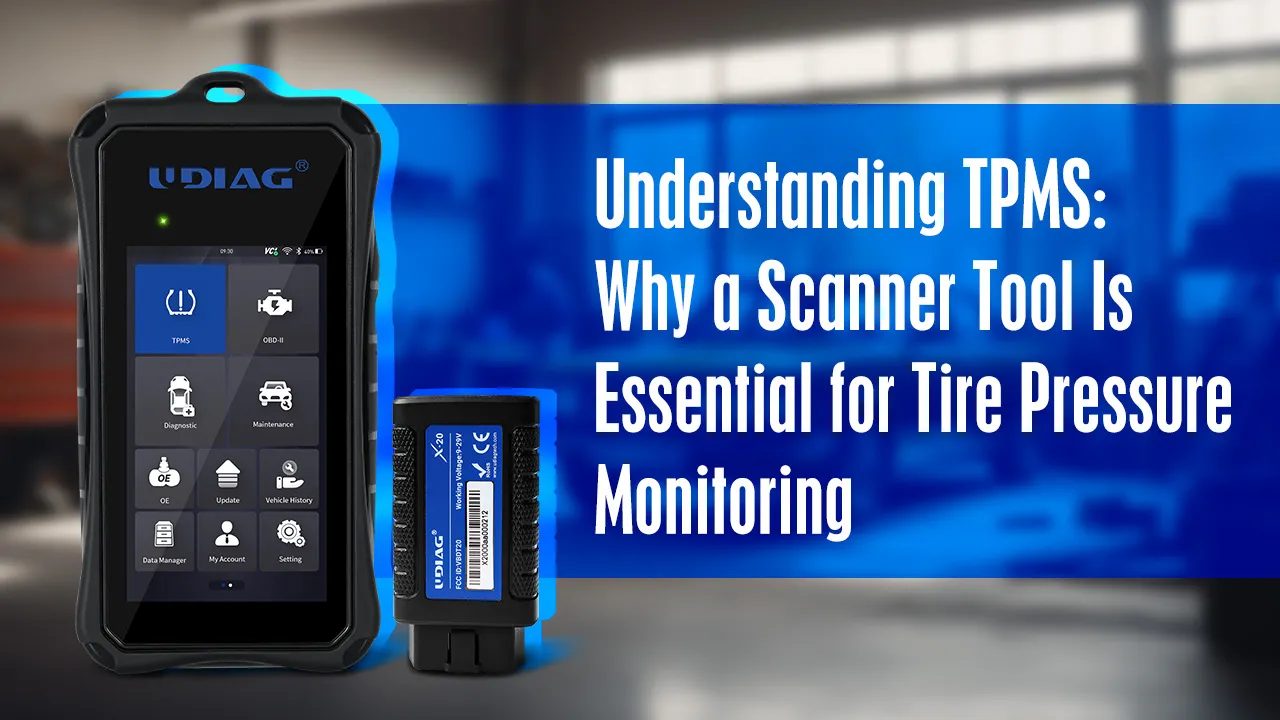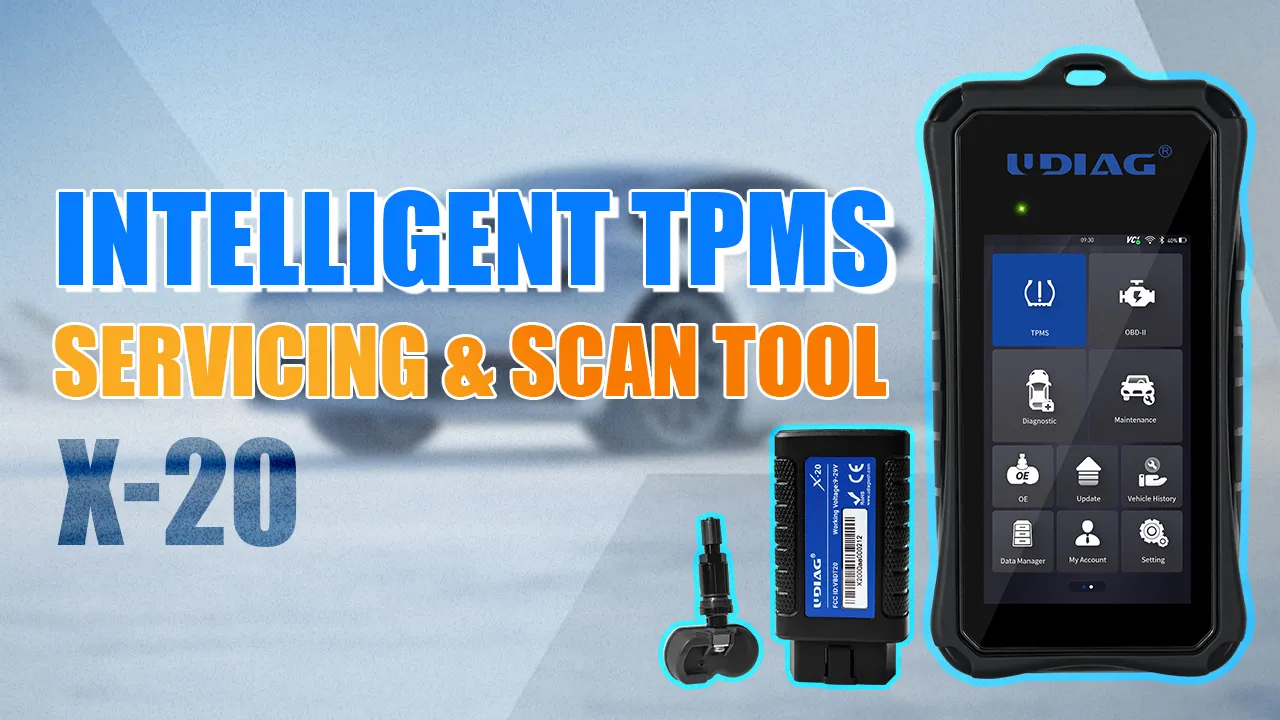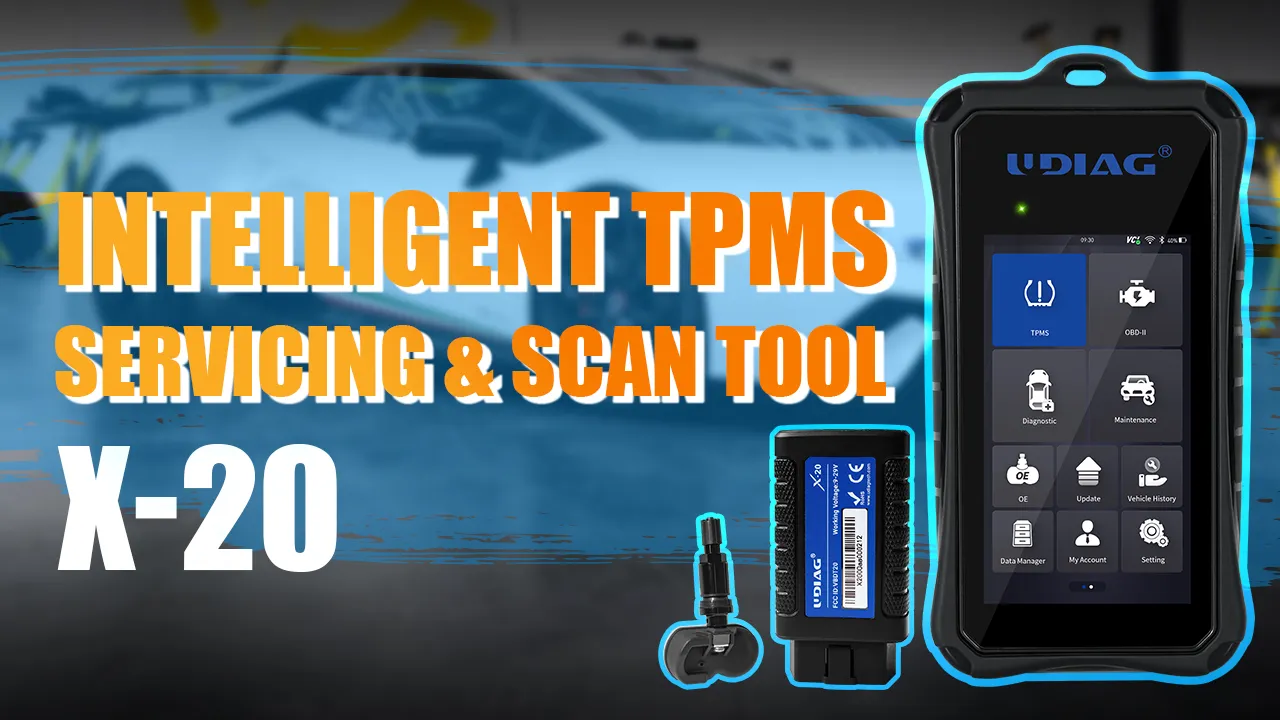Understanding TPMS: Why a Scanner Tool Is Essential for Tire Pressure Monitoring
2025-07-08 by UDIAG

Introduction:
How important is tire safety to every driver when their car is on the road. One of the key components to maintaining tire health is the tire pressure monitoring system (TPMS). Not only does this system sound an alarm when tire pressure is low, it also helps prevent accidents and improve fuel efficiency. To effectively diagnose and maintain TPMS, I recommend using a reliable tool like the UDIAG X-20 TPMS scanner. In this blog, let’s take a deep dive into TPMS, scan tools, and how to keep your vehicle’s system in top shape.
What is a TPMS Sensor?
So, what is a TPMS sensor and how does it work? TPMS stands for Tire Pressure Monitoring System. These sensors monitor the air pressure in your tires and sound an alarm if it’s too high or too low. The TPMS sensor is usually located inside each tire, mounted on the valve stem. It measures tire pressure and sends the information to the car’s computer. If the pressure drops below a certain level, the system triggers a warning light on the dashboard. This is crucial because underinflated tires can lead to poor handling and increased wear.
Now, let’s break down the three types of TPMS sensors.
- The first is a direct TPMS, which installs a pressure sensor in each tire to provide real-time tire pressure readings.
- The second is an indirect TPMS. Instead of using actual sensors in the tires, it monitors wheel speeds through the ABS system. If one tire is underinflated, it will spin faster than the others, triggering a warning.
- Finally, there are hybrid types, which combine elements of direct and indirect systems. Understanding these differences can help you better understand your vehicle and how to maintain it.
Comparison of TPMS Sensor Types
| TPMS Sensor Types | Description | Advantages | Disadvantages |
| Direct TPMS | A pressure sensor is used inside each tire | – Provides real-time pressure readings. – More accurate data. |
– Costs more to replace. – Requires battery maintenance. |
| Indirect TPMS | Wheel speed monitoring via ABS system | – Cheaper. – No additional sensors required. |
– Not very accurate; depends on wheel rotation. – May not detect small pressure changes. |
| Hybrid TPMS | Combines features of direct and indirect systems | – Balance between accuracy and cost. – Can provide backup data. |
– May be more complex to diagnose. – May present compatibility issues. |
Detecting a problem with the Tire Pressure Monitoring System (TPMS)
So how can you tell if a TPMS sensor is malfunctioning? One obvious sign is a warning light on your dashboard that stays on or flashes. This usually means one or more tires are underinflated or the sensor itself is malfunctioning. If you notice that the tire pressure is normal but the light doesn’t go off, the problem could be with the sensor. Other signs include tire wear or unusual handling. If your vehicle feels strange, it’s worth checking.
To diagnose TPMS problems, we usually recommend a few tools. A simple tire pressure gauge can help you check the pressure in each tire directly. That way you’ll have a clear idea if tire pressure is the problem. Alternatively, an automatic tire pressure scan tool can be used, which can read sensor data and identify errors. This tool is great for pinpointing a faulty sensor. While there are some high-tech diagnostic devices on the market, we’ll start with the basic tools.
Even without tools, you can still check the status of your tire pressure monitoring system (TPMS). First, visually inspect each tire for signs of damage or low tire pressure. A leaking tire is a clear sign of a problem. Keep a tire pressure gauge on hand for quick checks.
If you want to check your TPMS like a professional mechanic, using an OBD2 scanner is your best bet. This tool gives you a deeper look into your car’s data to help identify any issues with the sensor. It provides real-time information, making it easier to pinpoint the problem. By connecting the scanner to your vehicle’s diagnostic port, you can quickly assess the TPMS and pinpoint any specific issues that may be affecting the sensor.
Keep Your TPMS in Good Condition
Resetting the TPMS sensors after changing tires is a simple process. First, make sure the new tires are properly inflated to the recommended pressure. You can reset the system with a TPMS reset tool or use a car scanner like the UDIAG X-20 for more advanced diagnostics. This scanner allows you to communicate directly with the sensors and effectively reset the TPMS.
Some vehicles, such as many models from Honda, Toyota, and Ford, also allow you to reset the system through the dashboard menu. If your car has a reset button, look for it under the steering wheel or in the glove box. Press and hold the button until the TPMS light flashes and then turns off, indicating that the system has been reset.
Recognizing the signs that a TPMS sensor needs to be replaced is critical to safety. A persistent warning light on the dashboard even after checking tire pressure. Inconsistent sensor readings, especially when one tire doesn’t seem to have the right pressure. A beep or display message indicates a sensor failure. Unusual tire wear indicates a pressure problem.

TPMS Indicator Lights and Readings
The TPMS light is essential to maintaining tire safety. Here are the different types of TPMS lights you may encounter:
- Solid yellow light: Indicates that one or more tires are low on pressure. Always check tire pressure and inflate as needed.
- Flashing yellow light: This indicates a malfunction in the TPMS system itself. This could indicate a problem with the sensor, or a communication problem with the vehicle’s onboard computer.
- Red light: A serious alert that typically indicates dangerously low tire pressure. Immediate action is required to prevent tire damage or loss of control.
- Separate low pressure light: Some vehicles, such as some Honda and Chevrolet models, have dedicated low pressure lights that indicate a specific tire that needs attention.
The Impact of Temperature Fluctuations on TPMS Readings
Temperature fluctuations can significantly affect tire pressure, causing inaccurate TPMS sensor readings. Sudden drops or spikes in temperature can cause rapid changes in tire pressure, triggering false alarms. A TPMS scanner tool can help you monitor these fluctuations and ensure that sensor readings are accurate.
Using a car scanner, such as the UDIAG X-20, is essential for diagnosing these issues. This scanner can read data from your TPMS sensors and identify any fault codes, allowing for precise troubleshooting. By connecting the scanner to your vehicle’s OBD2 port, you can quickly determine which sensors are malfunctioning and take appropriate action, ensuring your TPMS system remains effective and your tires remain safe.

Conclusion
All in all, TPMS scanners are an indispensable tool for vehicle maintenance. They help mechanics and service providers ensure that TPMS systems are operating effectively, detect potential problems early, and maintain the safety and efficiency of vehicles. Investing in a high-quality TPMS scanner is essential for any modern repair shop.
If you need a TPMS scan tool. UDIAG is a trusted brand, and we offer professional scanning diagnostic tools.
Keeping TPMS in top condition is essential for your road safety. Regular inspections and timely diagnosis can prevent the severity of problems. With the UDIAG X-20 scanner, you can easily read fault codes and troubleshoot TPMS problems on your own, saving the cost of a mechanic visit. This reliable tool allows you to effectively take care of tire health and maintain the performance of your vehicle.


